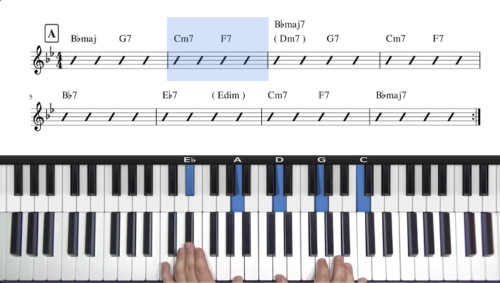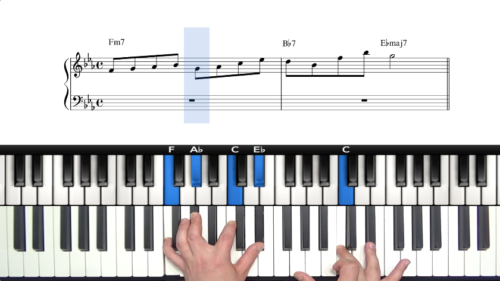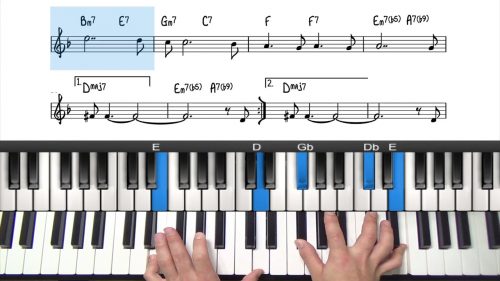How To Play Like Bud Powell
In this lesson we will take a look at one of the leading figures in the development of bebop and modern jazz, Bud Powell. Together with Thelonious Monk, Bud Powell is one of the main influences on jazz pianists since the 1940s.
Bud Powell was born September 27, 1924 in Harlem, New York City and died July 31, 1966 in New York. He started playing piano at an early age, with Art Tatum, James P. Johnson and Fats Waller as early influences.
Thelonious Monk was Powell’s greatest mentor early in his career and he introduced Powell to the circle of musicians who performed and hung out at the legendary Minton’s playhouse. The pioneers of the new style of jazz know as bebop were Charlie Parker, Dizzy Gillespie, Kenny Clarke and Charlie Christian, just to name a few. Minton’s Playhouse played a crucial role in the development of jazz in the 40’s, hosting concerts and regular jam sessions.
Bud Powell recorded in many different settings, from solo piano, piano trio to quintet. As a sideman he worked with pretty much everyone, including Charlie Parker, Dizzy Gillespie, J.J. Johnson and Sonny Stitt. Important recordings worth checking out are: The Amazing Bud Powell Vol. 1 and Vol. 2, Bud Plays Bird, and Bud Plays Thelonious Monk.
The Transcription
For this lesson I have picked a transcription of the Bud Powell solo on a rhythm changes called Sonny Side, from a record called Sonny Stitt/Bud Powell/J. J. Johnson (also released as All God’s Children Got Rhythm). This is one of my favorite records in general, and one of the strongest examples of Bud Powell’s playing in my opinion.
Practice Tips
-
This tune uses the Rhythm Changes progression, which is commonly used in bebop. If you are not familiar with this progression check out the related video above.
-
Notice Powell's effective use of chromatic approach notes in many phrases in this transcription. They usually approach a chord tone on the beat from a half-step below. It is worthwhile becoming familiar with these approach notes as they are an integral part of the bebop style.
-
Choose a short phrase from this transcription and practice improvising with it on similar chord progressions on different tunes, perhaps also learning it in several different keys.





Hi there, I found this analysis very interesting and helpful. At about 11.00 you refer to D over F7 (F Eb A – Gb A D) as a ‘dominant diminished.’ I’ve not come across dominant diminished before – could you please explain? – it looks like a standard F13 b9. Thanks.
Hi Ken, thanks for writing, I’m glad to hear you enjoyed the lesson!
Clearly you’re familiar with the concept already, but here are some info about the subject.
The term ‘dominant diminished’ refers to the diminished scale behind the dominant chord with b9 (in this case F13b9 as you mentioned), please check the attachment.
The diminished scale is the ‘core’ of dominant functions in tonal music; in it’s symmetry in minor 3rds it ties together 4 different dominants, in this case as it’s the F7b9, you can discover 3 other dominants deriving from the same diminished scale’s diminished chord (see the attachment).
Therefore as an easy but good and strong tool for improvising, you can find 4 major triads from the diminished scale to use over a dominant b9 chord, in F7’s case they would be F, Ab,B and D (attahcment), and here Bud Powell used the D triad.
Of course there are plenty of other triads you can find and use that derive from the diminished scale, and as the scale is symmetrical, any pattern or melodic structure that fits the scale can be played in 4 places (in minor 3rds) within the scale.
If you’re interested in the topic, please go check out the following tutorials:
https://www.pianogroove.com/jazz-piano-lessons/advanced-improvisation-course/
https://www.pianogroove.com/jazz-piano-lessons/diminished-patterns-licks-improvisation/
Also if you’re a fan of Bud Powell, here are more transcriptions/analyzes/ discussions on his brilliant work:
https://www.pianogroove.com/community/c/improvisation-exercises/30
Thanks, let me know if you have any further questions!
All the best,
-Tuomo
Thanks Tuomo – that’s very helpful. Thanks for the clear explanation! I’ll have a look at the tutorials and discussions you mention as well.
Kind regards, Ken